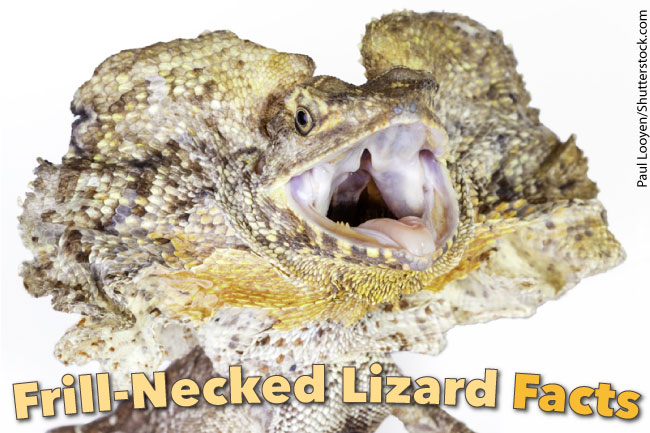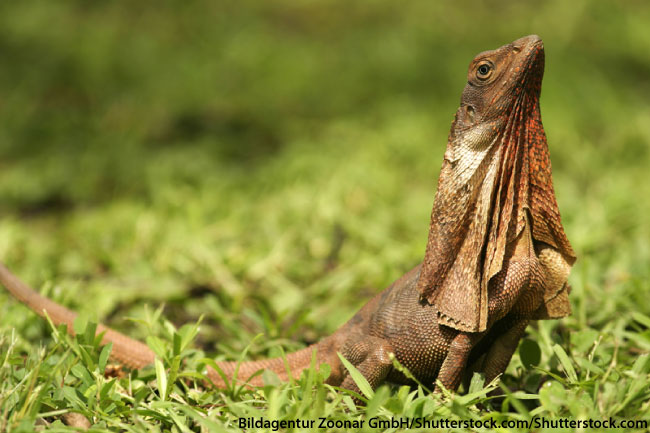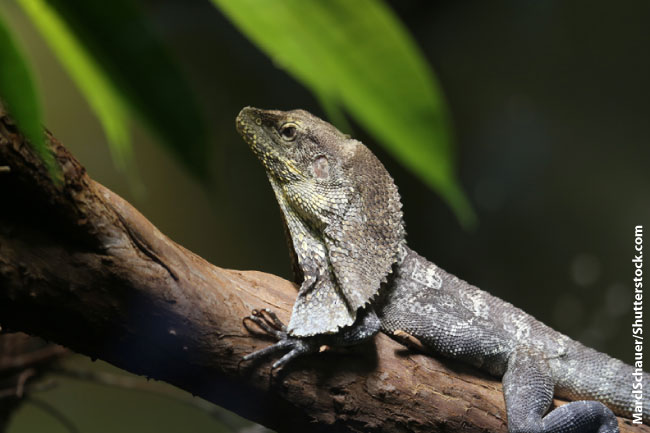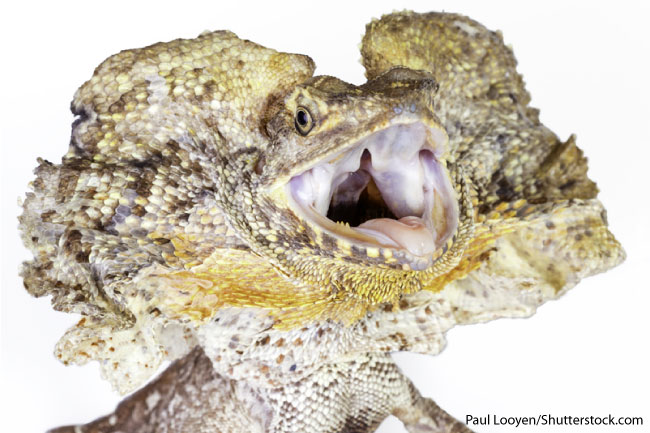This page contains Frill-Necked Lizard facts for kids and adults, and is part of our Australian Animals series. Want to know what a Frill-Necked Lizard looks like, where it lives, what it eats … and what eats it? Read on to find out all of this and much more …
(Don't forget to watch the video of a fierce Frill-Necked Lizard chasing a cameraman!)
Frill-Necked Lizard Facts And Information: Introduction
Frill-Necked Lizards are also known as ‘Frilled Lizards’ and ‘Frilled Dragons’. These fierce-looking lizards are found in Northern Australia. They get their name from the frill of loose skin around their neck. When the lizard is alarmed or angry, it raises this frill. This makes the lizard look bigger than it actually is, and helps to scare off predators and rivals.
Scientific Name & Science Stuff
There are more lizards than any other type of reptile. Around 6,000 species of lizard have been discovered. Lizards are identifiable by their long bodies and tails, short legs, and scaly skin.
The scientific name for a Frill-Necked Lizard is Chlamydosaurus kingii. It is the only member of the Chlamydosaurus genus. (A genus is a group closely-related animals.)
Frill-Necked Lizards are in the Agamid family of lizards. Many Agamidae (members of the Agamid family) have the word ‘dragon’ in their names. Another name for the Frill-Necked Lizard is ‘Frilled Dragon’.
Another well-known Agamid is the Bearded Dragon, which is a popular pet.
What Does A Frill-Necked Lizard Look Like?
The Frill-Necked Lizards is a medium-large sized lizard. It grows to around 85cm (2.75 feet) long from its nose to the tip of its tail. Frill-Necked Lizards weigh around 0.5 kg (just over 1 lb).
Male Frill-Necked Lizards are larger than females.
The Frill-Necked Lizard’s scaly skin is patterned, with patches of lighter and darker colours. Most have dark, plain colours. The lizard's skin provides excellent camouflage against tree trunks and branches.
The colour of the Frill-Necked Lizard’s skin varies depending on where it lives. Frill-Necked Lizards that live in tropical forests may have brown and dark green colours. Frill-Necked Lizards that live in desert regions may have reddish-brown skin.
The Frill-Necked Lizard’s Frill
The most noticeable feature of the Frill-Necked Lizard’s appearance is its frill. This hangs loosely over the lizard’s back most of the time. However, when the lizard is agitated it raises its frill, making its head look much bigger. The lizard often hisses while doing so.
The frill is a lighter colour than the lizard’s body and is designed to startle predators. The frill is raised with lengths of cartilage (a soft, bone-like substance) attached to the lizard’s jaw bones.
Running On Two Legs
The Frill-Necked Lizard has another useful defence strategy: running away! If its scary frill display doesn’t frighten off a predator, the Frill-Necked Lizard can run away on its two back legs.
You can see what a Frill-Necked Lizard looks like in the video below.
Cold-Blooded Creatures
The Frill-Necked Lizard is ‘ectothermic’ (cold-blooded). This means that it cannot regulate its own body temperature. The Frill-Necked Lizard has to bask in the sun in order to warm its body up to the required temperature.
It is thought that the Frill-Necked Lizard’s frill is also used to control its body temperature.
Where Is The Frill-Necked Lizard Found?
The Frill-Necked Lizard is found in northern Australia and southern New Guinea. In Australia, it is found in the northern parts of Western Australia, Northern Territory, and Queensland.
Frill-Necked Lizard Habitat
The Frill-Necked Lizard likes a humid environment, and is found in the tropical rainforests and savannas of Australia and New Guinea. It is also found less frequently in desert environments further south in Australia.
The Frill-Necked Lizard is arboreal, which means that it lives in trees.
Frill-Necked Lizard Behaviour
Frill-Necked Lizards spend most of their lives in trees. This is where they find most of their food, and where they are best hidden from predators. They are very hard to spot when tucked up against tree trunks and branches.
Frill-Necked Lizards only come down to bask in the sun, feed, and mate.
Frill-Necked Lizards mate in the wet season. During this time male Frill-Necked Lizards fight among themselves. The females lay their eggs (around 8-23 at a time) in underground nests. Two clutches are laid each year.
What Do Frill-Necked Lizards Eat?
Frill-Necked Lizards are carnivores (meat eaters), and feed on a variety of small animals such as insects (particularly butterflies and moths), mammals and other lizards.
What Animals Eat Frill-Necked Lizards?
A number of animals feed on Frill-Necked Lizards. Birds of prey, snakes, other lizards, dingoes and feral cats.
Are Frill-Necked Lizards Endangered?
Frill-Necked Lizards are not endangered, but like many animals are threatened by habitat loss caused by farming and other human developments.
Frill-Necked Lizard Facts For Kids
- Frill-Necked Lizards are reptiles.
- The Frill-Necked Lizard’s scientific name is Chlamydosaurus kingii. It is the only member of the Chlamydosaurus genus, and is in the Agamid family of lizards.
- Frill-Necked Lizards are found in northern Australia and southern New Guinea.
- The Frill-Necked Lizard’s most recognisable feature is the large frill of skin around its head, which can be raised to scare off predators.
- The Frill-Necked Lizard is arboreal (lives in trees). It is well-camouflaged against the branches.
- The frill of the Dilophosaurus dinosaur in Jurassic Park was inspired by the Frill-Necked Lizard’s frill.
- Frill-Necked Lizards can live between 15 and 20 years in captivity.
- The Frill-Necked Lizard is ectothermic (cold-blooded), and cannot control its own body temperature. It has to bask in the sun to reach the right temperature.
- The Frill-Necked Lizard is not endangered.
- Frill-Necked Lizards can run on their hind legs. If the Frill-Necked Lizard’s frill fails to scare off a potential predator, the lizard will run away on two legs towards the nearest tree.
Conclusion & Related Pages
We hope that you have enjoyed learning about this awesome lizard. Visit the following pages to discover more about Australian animals and reptiles:
- You can discover more amazing Australian animals on this page: Australian Animals List.
- See more Australian reptiles on this page: Australian Reptiles Pictures & Facts
- Discover amazing lizards from all around the world: Types of Lizards - Pictures & Facts
- Visit this page to become a reptile expert: Reptiles - The Ultimate Guide





